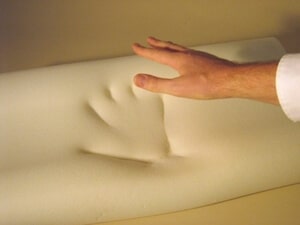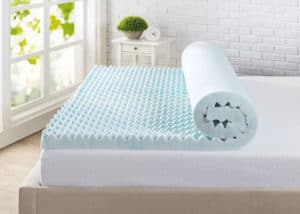We hope you love the product we recommend! Just so you know, at no extra cost to you, we may get a small commission for purchases made through links in this post. Your support is appreciated. Enjoy the read!
Ah, the age-old debate.
Visco latex vs memory foam.
What’s the difference between the two? Aren’t they all just mattresses? Which one should I get?
All these questions….will be answered if you keep on reading!
What is Latex Foam?
Latex foam mattresses are durable and natural foam mattresses. Latex foam is derived from the sap of the rubber tree referred to as Hevea brasiliensis.
The tree is a native species in the Amazon, but it can also be found in Northeast Asia and Western Africa.
It is also called the latex tree.
Pros
- Provide excellent support
- Very durable
- It can naturally repel mold and dust mites
- Excellent aeration
- Fast recovery time. The mattress goes back to its original shape fast when you leave your bed
Cons
- Labor intensive
- Quite pricey
- Heavier compared to other foam mattresses
Two Ways to Make Latex
There are two methods of processing latex mattresses. They include:
- Dunlop
- Talalay
 Dunlop latex
Dunlop latex
This manufacturing process started in 1929, and it is a process that is known to produce firmer mattresses than Talalay latex.
The durability and firmness of Dunlop latex mattresses are unquestionable because the foam to air ratio is high, which increases their density.
Additionally, the process requires relatively less work, and it is also eco-friendly.
Initially, the firmness of Dunlop latex was inconsistent, but as technology continues to evolve, that has become a non-issue.
 Talalay latex
Talalay latex
While this manufacturing process involves pouring liquid latex into a mold.
The mold is partially filled, but the air is added into it through a vacuum, allowing the latex to expand to form a complete form.
As a result, Talalay latex mattresses are less dense, softer, and lighter compared to Dunlop latex mattresses.
However, the process is known to produce mattresses with a consistent density.
It is critical for you to know that this process is more expensive, and it takes longer and more work to produce the mattresses.
How does latex feel?
Conforms to Your Body & Reliefs Pressure
When it comes to contouring abilities, latex mattresses provide you with great comfort.
A latex mattress supports your waist and legs, including your hips and shoulders to provide you with restful sleep.
Besides, it supports your neck, and the spring-like feel enhances your comfort.
But wait, there is more.
Latex mattresses are built to target your body’s pressure points, enabling them to contour to your body regardless of your sleeping position.
Moreover, these mattresses provide cushioned support.
They come in different sizes – soft, medium, extra firm, and medium-firm.
The thickness also varies, allowing you to select a mattress that suits your sleeping habits.
The mattresses are also designed with supportive latex core, which delivers superb support.
That notwithstanding, they have comfort layers that target your pressure points.
Added Bounce, Wicks Heat & No Motion Transfer
Latex mattresses are also quite bouncy.
The fact that they are made from latex enhances this effect.
What’s more, you don’t have to worry about this bouncy feeling ending.
The mattresses are quite durable, and they can last for over 20 years without sagging or having any indentations.
Latex mattresses also feature superior quality.
They have a certification known as the Global Organic Latex Standard (GOLS), which assures you of their quality standards.
When it comes to aeration, you have nothing to worry about latex mattresses.
Unlike memory foam mattresses that retain your body heat throughout the night, latex mattresses allow air to flow freely.
That enables the heat and moisture to escape, keeping you comfortable all night long.
Latex mattresses also have motion isolating qualities, which minimize disturbances, especially to those people who sleep with a partner.
Who is latex for?
A latex mattress is made with all-natural latex, but you can also find other types, which include blended and synthetic latex mattresses.
A latex mattress is meant for individuals who are looking for a mattress that will offer pressure point relief and body support.
It is also suitable for all type of sleepers – stomach, side, and back.
However, you should know that they are a bit pricier compared to other foam mattresses.
What is Memory Foam?
 Memory foam was mainly introduced in the 1970s by NASA.
Memory foam was mainly introduced in the 1970s by NASA.
The main aim of developing this material was to offer crash protection and improve seat cushioning for pilots and passengers alike.
Besides being used in mattresses and pillows, memory foam has a wide range of commercial applications.
Although the popularity of memory foam came to be between the 1960s and 1970s, the initial work on the polyurethane polymers that make memory foam began in 1937.
The works were carried out by Otto Bayer and his co-workers.
Pros
- Offers excellent spinal and neck bone support
- Has great support
- Easy to care for
- Ideal for all types of sleepers
- Eliminates motion
- Good for pressure point relief
- Quality construction
Cons
- It retains heat, which can cause discomfort
- Might be uncomfortable for a stomach sleeper
- Have a strange smell, especially when new
- Have a slower response time. It takes longer to get back to the original shape when you leave your bed.
- Too firm
How Memory Foam is Made
So, how exactly is memory foam made? Memory foam mattresses start as polyurethane foam, which is a mixture of halocarbons, water, polyurethane, and hydrocarbons.
The chemical added to polyurethane cause it to form a comfortable sleeping platform.
Keep in mind that you can mix polyurethane with specific chemicals to make other products such as spray liner.
Today, memory foam mattresses are made by mixing a polyol with water and a diisocyanate. Doing this allows the foam to expand, and it has an open cell structure, which enables it to spring back slowly from the pressure.
During the initial stages of memory foam production, gases are introduced into the solution to form a bubble matrix.
The size of these bubbles varies with the chemicals applied.
Moreover, a foam that has a more open cell structure allows more airflow through it.
How does Memory Foam Feel?
A good quality memory foam mattress should distribute your body weight evenly, and focus on your pressure points to increase your sleeping comfort.
Normally, a memory foam mattress offers great support to all types of sleepers, but it is mainly meant for side sleepers.
Memory foam is processed using polyurethane and other materials.
This composition gives these mattresses a visco-elastic feel when you sleep on them.
What is Indentation Force Deflection?
It is vital for people to know that memory foam mattresses have different levels of firmness, which is rated by the Indentation Force Deflection (IFD) or Indentation load Deflection (ILD).
They both mean the same thing.
The rating measures the force in pounds needed to make a 25 percent indentation in a 4-inch thick foam.
For example, an IFD of 10 lb means that it takes 10 lb to make the foam indent by 4 inches. The density and IFD of your memory foam mattress determine its longevity, firmness, and softness.
Different Memory Foams
Memory foam can be fully or partially infused with gel, gel beads, graphite, copper, and other material.
The mattresses also come in different forms.
Some have holes in the top, others have channels in the bottom, while, others are molded.
Memory foam is categorized among the most popular and revered foam mattresses on the market.
Apart from being suitable for side sleepers, the mattresses also suit individuals who suffer from pressure point-related pain.
Keeps You Cool & Eliminates Motion
However, if you are in search of a mattress that keeps you cool throughout the night, then memory foam might not be the mattress for you.
Why?
It retains your body heat throughout the night, resulting in less air flow.
Moreover, a lot of material covers your body because of its contouring and deep sinkage, limiting cooling.
Memory foam is designed to support every part of your body evenly, and that makes it ideal for back and neck alignment.
The mattress keeps your body in a neutral position, eliminating pains in such areas.
Additionally, memory foam eliminates motion.
That is a beneficial feature to individuals that share a bed.
Instead of transferring motion when one person moves or gets out of bed, the foam material absorbs the motion.
It ensures no one is disturbed when sleeping.
Who is Memory Foam for?
- A memory foam mattress is ideal for people who are looking for a mattress that offers excellent support.
The mattress usually has more sinkage to hug your body tightly.
- The mattress is also suitable for side sleepers, and those who want a slower response time.
When the mattress sinks, it doesn’t flatten out fast, and that quality delivers deep pressure relief.
That notwithstanding, memory foam also has hypoallergenic qualities.
- That makes it ideal for people that suffer from fabric-related allergies.
Moreover, the dense nature of this mattress limits the probability of dust mites thriving inside it.
Does polyurethane foam contain latex
Polyurethane foam is a type of synthetic foam that is commonly used in a variety of applications, including furniture, bedding, and automotive seating. It is made from a polymer called polyurethane, which is derived from petroleum and other organic materials.
Latex is a natural substance that is derived from the sap of certain plants, such as the rubber tree. Latex is often used to make a variety of products, including gloves, condoms, and foam rubber.
Polyurethane foam does not contain latex. However, some products that contain polyurethane foam, such as mattresses and pillows, may also contain a layer of natural latex foam as a comfort layer. If you have a latex allergy, be sure to check the product labels carefully to ensure that the product you are considering does not contain latex.
Spring mattress vs foam mattress vs latex mattress
Spring mattresses are made from metal coils or springs that are encased in fabric. They provide support and stability, and are generally more affordable than other types of mattresses. The main disadvantage of spring mattresses is that they can create a lot of motion transfer, which means that if you sleep with a partner, you may feel their movements more.
Foam mattresses are made from layers of polyurethane foam, memory foam, or a combination of both. They are known for their ability to contour to the shape of your body and provide pressure relief. Foam mattresses are generally more expensive than spring mattresses, but they are also more durable and tend to have less motion transfer.
Latex mattresses are made from layers of natural or synthetic latex foam. Like foam mattresses, they are known for their ability to contour to the body and provide pressure relief. Latex mattresses are generally more expensive than spring mattresses, but they are also more durable and tend to have less motion transfer. They are also a good option for people with allergies, as they are hypoallergenic and resistant to dust mites.
When choosing a mattress, it’s important to consider your personal preferences and needs. Consider factors such as your budget, your sleep position, and any specific health concerns you may have. It may also be helpful to try out several different types of mattresses in a store or showroom before making a decision.
Latex vs Memory Foam FAQ
Is latex the best mattress?

We highly recommend it for you, but there are several factors that determine if it is the best fit for you.
A latex mattress is best for you if you want a mattress that provides more bounce, and this mattress beats memory foam at that.
Moreover, it is made of all-natural rubber that has hypoallergenic properties.
And it also has a faster response time.
Overall, a latex mattress is best.
Is latex or memory foam better for back pain?
A latex foam mattress is better at alleviating back pain compared to a memory foam mattress.
How come?
Well, latex foam is made of high-quality natural rubber, which makes it firmer.
The firmness helps to support your spine, eliminating chronic back pain effectively.
Moreover, it fully supports your body’s curves, ensuring that you sleep in a comfortable position to alleviate back pain.
On the other hand, memory foam can also help with back pain, but it is mainly meant for side sleepers.
The memory foam conforms to your body shape to help alleviate lower back pain.
Is latex mattress good for side sleepers?
Yes.
A latex mattress is perfect for side sleepers.
Why?
The mattress delivers excellent contouring, plus it has cushioned support.
These qualities keep your spine aligned when you are lying on your side.
That notwithstanding, latex mattresses have different firmness levels, allowing you to choose a mattress that conforms to your sleep style.
Does memory foam contain latex?
No.
Memory foam does not contain latex.
It is a technologically advanced polyurethane foam with some added materials, and latex is not one of its components.
Can you put latex topper on a memory foam mattress?
Yes.
You can put a latex topper on your memory foam mattress.
Several reasons might make you take that course of action.
For starters, a memory foam retains heat, which makes it uncomfortable during the night.
A latex topper, however, has air channels, which allow air to circulate effectively to provide a cooling effect.
Additionally, you can place a latex topper on a memory foam if you want to give your mattress an extra spring.
The thin latex topper over your memory foam makes you feel like you are floating over the mattress.
You also need to settle for a thicker latex topper if you want more comfort.
Final Thoughts: Latex vs Memory Foam - Which One Is Better?
Generally, latex and memory foam are some of the most preferred mattress materials.
Each material is suited for many different types of sleepers; therefore, you have to make a careful assessment when choosing one based on your sleeping style.
Overall, latex foam is better than memory foam because of these factors:
- Latex mattresses provide extra bounce, which eliminates unwanted sinking
- Latex responds quickly as you move through the bed at night
- It’s not made with harsh chemicals and can be made with 100% natural or organic materials
It’s important to get a mattress that suits your sleeping style.
You have to make sure that you settle for a mattress that balances support, comfort, and your health.
If you have been wondering which mattress to get for your sleeping needs, we hope that this article on latex vs memory foam helped!
>> If you’re like me and also suffer from allergies, click here to see which mattresses are ideal for you! <<






